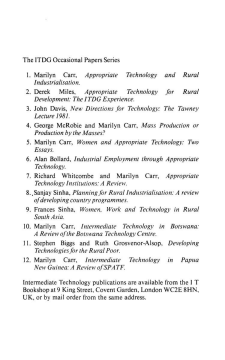
Additional Information
Book Details
Abstract
This selective review looks at case studies where NGOs have been involved in rural/agricultural technology programmes directed at the rural poor, and attempts to identify those common features which characterize the agencies that have met with success. (Published in the ITDG Occasional Paper series).
Table of Contents
| Section Title | Page | Action | Price |
|---|---|---|---|
| Title Page | i | ||
| Copyright Page | ii | ||
| Table of Contents | iii | ||
| I. Introduction | 1 | ||
| II. Crops | 4 | ||
| A. Universities and Research Organisations | 4 | ||
| 1.CIMMYT | 4 | ||
| 2.IRRI | 14 | ||
| 3. ICRISAT | 16 | ||
| 4. ICARDA | 21 | ||
| 5. IITA | 23 | ||
| 6. CIAT | 24 | ||
| 7. ICA | 24 | ||
| 8. G.B. Pant Agricultural and Technology University | 27 | ||
| B. Government Agricultural Departments | 32 | ||
| 1. Indonesia | 32 | ||
| 2. The Gambia | 34 | ||
| C. Non-Government Organisations | 36 | ||
| 1. FUNDAEC | 36 | ||
| 2. Lirhembe Multi-Service Cooperative, Kenya | 37 | ||
| 3. ASAR/ARADO | 39 | ||
| D. International Development Agencies | 41 | ||
| E. Informal Research and Development | 44 | ||
| 1. Bangladeshi Farmers | 44 | ||
| 2. Grameen Bank Project, Bangladesh | 47 | ||
| III. Irrigation | 49 | ||
| A. Government Agricultural Departments | 49 | ||
| B. Local Non-government Organisations | 51 | ||
| 1. Proshika | 52 | ||
| 2. UNICEF/NGO Water Project Steering Committee, Kenya | 54 | ||
| 3. Gram Gourav Pratisthan (GGP), India | 57 | ||
| 4. Utooni Development Project (UDP), Kenya | 59 | ||
| C. International Agencies | 61 | ||
| D. Informal Research and Development | 63 | ||
| IV. Post-Harvest Technologies | 66 | ||
| A. Universities and Research Organisations | 66 | ||
| B. Local Non-Government Organisations | 75 | ||
| 1. Eastern Technical Institute (ETI), Sri Lanka | 75 | ||
| 2. Comilla Cooperative, Bangladesh | 77 | ||
| 3. Bangladesh Rural Advancement Committee (BRAC) | 79 | ||
| C. International Agencies | 82 | ||
| 1. World Bank, India | 82 | ||
| 2. ITDG, Sri Lanka | 85 | ||
| 3. UNESCO/UNDP, Upper Volta | 87 | ||
| 4. AID | 89 | ||
| 5. Wheat Storage in Bangladesh | 90 | ||
| V. Draught Animal Technologies | 91 | ||
| A. Universities and Research Organisations | 91 | ||
| B. Government Agricultural Departments | 92 | ||
| C. International Agencies | 94 | ||
| 1. Overseas Development Administration | 94 | ||
| 2. Canadian International Development Authority, Sri Lanka | 96 | ||
| VI. Livestock | 97 | ||
| A. Universities and Research Organisations | 97 | ||
| B. Government Agricultural Departments | 99 | ||
| 1. Operation Flood, India | 99 | ||
| 2. Bee-keeping Cooperative, Honduras | 103 | ||
| VII. Summary and Conclusion | 106 | ||
| A. Definition of Clients | 106 | ||
| B. Characteristics of Viable Poverty-Focused Local Agencies | 106 | ||
| C. Policy Issues | 108 | ||
| Notes | 110 | ||
| Bibliography | 113 |
